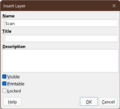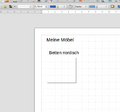Electrical installation plans in Draw
TDF LibreOffice Document Liberation Project Community Blogs Weblate Nextcloud Redmine Ask LibreOffice Donate
Foreword
The basis of this description is the Short guide "Installationspläne", in German, (Published on 2014-08-02. Based on LibreOffice version 4.1.3), in German.
Contributing authors of the Short Guide are: Volker Heggemann, Jochen Schiffers and Klaus-Jürgen Weghorn.
The drawings and images from the Short Guide are also used here.
The video shows how to create "Elektro-Installationspläne in Draw" under LibreOffice and links to this page here, which provides further information and details.
Link to the Video
Link to the Video (in German [DE]):
Elektro-Installationspläne in Draw erstellen
Basic information
Drawing scale
Depending on what you want to draw, it may be useful to preset the Drawing scale for the desired use before starting.
You can specify the Drawing scale in the menu via ▸ ▸ ▸ at Scale.
Or you select the Drawing scale in the Statusbar at Scale with a right-click.
Why do you need installation plans?
Various laws and regulations (all in German), such as VOB and VDE, require contractors and clients of buildings in Germany and also in Europe to document the trades created.
Technical documentation with an Office program
Advantages and disadvantages
Technical documents are created today as a rule with several programs.
In the technical area CAD programs are to be mentioned here above all in addition, 3D CAD and Renderer. (CAD = computer-aided design)
From a certain extent these are to be used in any case, since office programs are usually designed for versatility and it requires special functions for large projects.
Disadvantages
- Special functions are only available in special programs (CAD)
- Graphical and textual functions are distributed in different office areas (Writer, Draw,...) not usable for large projects
- Component libraries are not readily available for Office formats.
Advantages
- The document format is "open" (ODF - format).
- LibreOffice suite is a "Free Open Source Software". It is therefore free to download, free to use and free to distribute. Download LibreOffice
- For small and medium projects fast, flexible and inexpensive.
- The familiarization and training is not so extensive due to the routine use of an office suite.
Minimum requirements
The ability to create vector graphics
The creation of installation plans requires a few important prerequisites.
Since the resulting plans usually have graphical content, vector - graphics capability is the top priority.
Integration of different contents
Contents of a technical documentation are usually divided into different parts.
For example, texts, scanned templates, dimensions, components, notes.
Layers
Because much of this content may refer to the same part of the documentation, information obscures each other.
On a building floor plan in plan view, a room text might obscure the overhead lighting sign.
It is therefore essential to group elements on individual, transparent pages, known as layers, which can be made individually visible, printable or lockable.
Support of different input and output formats
As already mentioned, the basis can be a scan or a CAD drawing. BMP, JGP, PDF should be supported as scan formats.
DXF or also SVG as vector graphic formats can often be provided by architecture offices.
The output and especially the archiving as ODF, PDF, SVG, PNG or other standardized and free formats are useful.
It would be nice if DXF files could also be saved again.
This may be the case in a later LibreOffice version.
Why LibreOffice
Quite simply - because it works.
Everything, or at least most of what is written here or in the Short Guide, can be applied to LibreOffice without further ado.
Whether and to what extent other office suites are able to do this cannot be judged in this context.
Electrical - installation plans
Initial situation is a template
From the client you get (in the worst case) a drawing on paper.
Today, however, there is usually a CAD plan on CD, stick or by e-mail.
This eliminates some work steps.
-
Paper template photo
-
Scan of the same project
Final situation
At the end you have a digital plan with different layers.
Here you can change everything by clicking.
Quickly you can insert further objects by copy & paste or delete single parts.
Office document
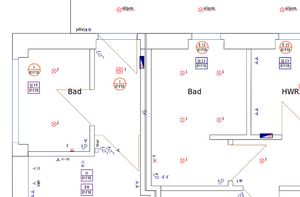
How such a plan is composed
In different levels individual elements of the plan are put together.
Considered one above the other these levels result in the whole plan.
Depending on how many different layers are created, individual information can be shown or hidden afterwards.
This results in the following picture on top of each other:
-
Three layers with information
-
General view of the layers
The floor plan of a building, texts with e.g. the names of the rooms, circuit symbols, dimensions, circuit numbers (or other notes) etc. are inserted one above the other in a Draw document.
Care is taken that the parts that belong together are also inserted in the same layer.
The simplest procedure
Is thus:
- Scanning an original plan
- Adjusting the colors or converting to gray scale
- Open a new Draw document
- Inserting the scanned plan into the lowest layer of the drawing
- Insert labels and notes into another layer. (e.g. texts for the designation of the individual rooms)
- set installation circuit signs on a new layer
- possibly create another layer with circuit numbers
- print the finished document
... but is not the best workflow
If this is the first and last installation plan you are creating, then the above is (also) a possible workflow.
Assuming that more plans are to be created in the future, the symbols, texts, and layers to be inserted will reappear in each plan, in whole or in part.
So there should be a kind of library with contents.
If, however, each template, no matter how large it is, is simply scaled down or enlarged to A4 format, then the symbols must be adapted to the scanned drawing each time.
The simple procedure is still supplemented by a few small things
- Scanning of an original plan
- Adjust colors or convert to grayscale (if necessary)
- Open a new Draw document
- Setting the page format according to the dimensions of our project and related to the scale 1∶100
- So if our small house with 10 × 10 meters should be scanned, then choose for example page size DIN A4 (which corresponds approximately to 21 × 29 cm), with a scale of 1∶100 you get so 21 × 29 meters displayed.
- For our large hall with the dimensions 25 × 40 meters now the page size of DIN A3 is set (29 × 42 cm) and the scale of 1∶100. Thus you can represent 29 × 42 meters in the Draw - document.
- Insert the scanned plan into the lowest layer of the drawing.
- If the drawing is available as a scaled, smooth (i.e. not distorted) image, it will be adjusted to scale.
- If the drawing is already available as a digital (vector) image from a CAD program, usually nothing more needs to be done with it, normally the scale already fits.
- In the example above, neither of these applies. Therefore, the scan serves only as a basis for the complete redrawing of the floor plans.
- Insert labels and notes into another layer. (e.g. texts for the designation of the individual rooms).
- put installation circuit signs (all designed in scale 1∶100') on a new layer
- possibly create another layer with circuit numbers
- print the finished document
Procedure step by step
Prerequisite
It is assumed that you are familiar with the basic working techniques of LibreOffice Draw.
Many functions can already be reached with the context menu via the right mouse button.
In addition it is presupposed that the target, as a installation plan, in this case an electrical installation plan, is understood.
Preparations
Preparations, which occur actually again and again and are often not made with the Office program, are likewise excluded.
So first the original plan should be available (if necessary as scan) and a new Draw - document should be opened.
Setting the Draw - document
The opened Draw - document is saved immediately.
A meaningful document name has surely advantages.
▸ ( Ctrl + ⇧ Shift + S )
You should now set the correct page format.
Assuming a scale of 1∶100, you can think of the centimeters for page width and height as the original width and height in meters.
On a DIN A3 sheet of 42 cm × 29 cm in landscape format you will get a project of 42 × 29 meters. (Certainly somewhat less, since usually still another edge is to run around the drawing).
-
▸ menu
-
"Page Properties" dialog
The page setting can be reached in the menu under ▸ .
For this tutorial, A4 landscape format is set there for the time being.
All other settings of the page format dialog remain in the default setting.
The scale of the page(s) is set in the options.
Select this setting with ▸ ▸ ▸ .
In the settings dialog you will find the scale and set it to 1∶100.
-
Set the scale of a drawing
-
▸ ▸ ▸
Scale factor
You can see the scaling factor of the document in the status bar.
With a right click on the display you can change the scaling factor.
Insert new layers for the original
At the bottom left of the workspace you can see the individual tabs for the layers.
By default there are the three layers "Layout", "Controls" and "Dimension Lines".
You can create a new layer by selecting ▸ from the menu.
-
"Insert Layer" dialog
-
"Layer" Context menu
This layer gets the name "Scan" and a Description like for example: "Scanned original of the architect Mustermann as of 31.12.2012".
In this way, another layer is created.
It gets the name "white area".
This layer will be used later to show a quick way to display the building floor plan.
Did you have a close look at the "Insert Layer" dialog?
There you can immediately set whether a layer is visible, printable or locked.
These properties are important later on.
You can reach these settings via the menu item ▸ or by right-clicking on a layer tab using the context menu ▸ .
Possible layers
- Scan
- white area
- Room texts
- Circuit numbers
- Symbols
- Notes
Your project may require more layers, create as many layers as you need.
Bring the scanned original into the new Draw document
Now select the "Scan" layer and choose ▸ .
In the dialog that appears, the file must be searched for and by pressing the button, the scanned drawing is inserted into our new document in the "Scan" layer.
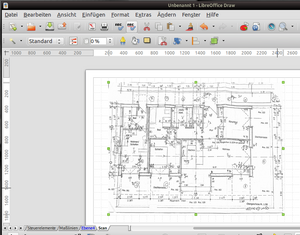
The image you have just inserted is marked by 8 small squares on the sides.
To deselect click next to the graphic or press the ESC key.
Now the inserted image should first be scaled.
So that the dimensions, for example the measurements in the drawing, fit together with the settings of the page.
Find a clearly visible area in your drawing with a horizontal dimension you know (or can see).
Doors are a good choice, since they usually have standard dimensions of 76 or 88.5 cm.
Zoom in on such an area if necessary.
Select in the "Drawing" toolbar the drawing tool for a dimension.

You will find it under the functions for lines and arrows at the bottom of the screen.
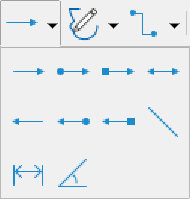
If the Drawing toolbar is not visible, select ▸ ▸ from the menu.
Now draw a horizontal dimension line.
Hold down the ⇧ Shift key while drawing to draw orthogonal dimension lines (lines at fixed angles of 0°, 45°, 90°, 180°, etc. to the page edges).
Of course, at first the dimension will not match the template.
But first, draw another dimension line.
This time, first find an area with a known or visible vertical dimension.
Usually there are door or window dimensions here as well.
If the dimension line drawing tool is no longer active, select it again.
Draw a vertical dimension line.
Also hold down the ⇧ Shift key to make the line completely vertical.
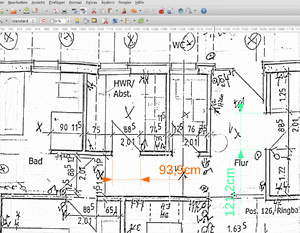
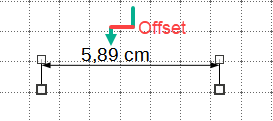
Now it's time to customize the drawing template.
Scaling this template
See if the dimension lines set in the previous section are too large or too small.
Accordingly, the entire document must now be enlarged or reduced.
Select all parts of the current document.
In the menu with ▸ or the keys Ctrl + A.
This ensures that the dimension lines change in size along with the plan.
You can first try to adjust the size with the mouse by moving the selected small corners until the dimension lines match the defaults of the template.
However, this is rarely successful.
However, you can adjust the dimensions approximately.
Now select ▸ ( F4 ) or right mouse button and change the values for width and height in steps.
Start with large values and decrease more and more until the dimension lines you draw show exactly the dimension given in the template.
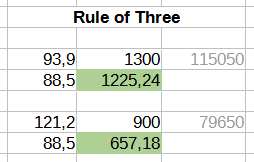
Of course, you can also calculate the new dimensions.
After selecting ▸ you will see the actual size of the selected drawing.
Suppose it says 1300 cm Width and 900 cm Height.
In this figure you can see that the horizontal dimension line 93.9 cm should correspond to a dimension of 88.5 cm.
By simple rule of three you now calculate the new width of the drawing.
And enter the result 1225,24 cm.
Proceed in the same way with the height.
From 900 cm become by = 657,18 cm as new height.
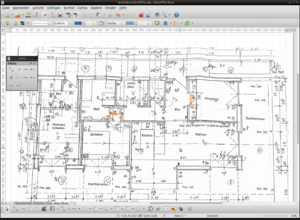
This completes the scaling.
First deselect the entire drawing.
Then select the two dimension lines one after the other and delete them afterwards.
Now the whole drawing should correspond to the scale.
If, however, as in the example pictures above, the scan was slipped or wavy, then not all dimensions will fit.
The only solution is to either create a new scan or to create the drawing from scratch on the basis of this scaling.
Remove unimportant drawing details
You do not need many details in the above drawing for an installation plan.
After all, the point is to show the location and type of installation.
Thus, as a general rule, all information except the floor plan is unimportant.
In addition to redrawing the floor plan (more on this below), there is another option using the layers.
Activate the layer "white area" or create another layer with the name.
Cover drawing details
Now all drawing details are covered by rectangles.
So draw a rectangle of any size in the "white area" layer.
Now move this rectangle to a corner of a room.
Then enlarge or reduce the rectangle to the size of this room.
-
Insert rectangle
-
Rectangle in (the upper, left) corner of the room
-
Size adapted to the area of the room
In this way, you can first cover all the faces with rectangles.
Maybe there are also areas in your template that you need to cover with circles, polygons or other areas.
It doesn't matter yet what color these rectangles are, the important thing is that you can see them and adjust them as you need them for your project.
After all surfaces are covered, you continue with the selection of individual or all rectangles.
In the example images, some areas (rooms) are deliberately not covered with rectangles to illustrate the effect.
In the following you can see how the Draw - document can look now.
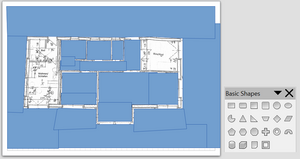
Now select all the rectangles.
Either all at once or one after the other.
Be careful not to select the drawing in the background.
When all rectangles are selected, set the color of the area to white.
Set the color of the lines of the rectangles also to white, or set the line style to "-none-".
▸ menu, Tab "Area" at "Fill|Colour" choose "White".
▸ menu, Tab "Line" at "Colour" choose "White".
or via the context menu
Click the right mouse button and select ▸ , tab ″Area″ the button .
Click the right mouse button for ▸ , tab ″Line″ select the button .
After that, you should only see the free areas of the lower layers.
Set the properties of the layer with the rectangles to Locked as well.
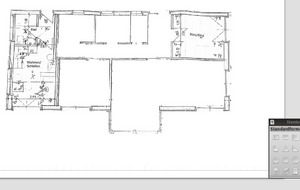
Recreate individual details
Overlaying makes parts of the template disappear that you may still need.
Doors are such a detail.
However, it makes sense to cover them anyway and then redraw them, because the door stops can always change again in the course of planning.
You can react to this in the installation plan and quickly adjust this.
If necessary, use the line function to redraw the room doors.
Labeling the individual sections
Individual rooms had a label before.
You can insert these now again.
This has the advantage that you can edit, change or move the text in the further process arbitrarily.
Remember to create a layer for these texts as well.
For example, a "Room texts" layer.
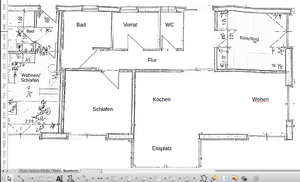
First, save this document.
The next step is to insert installation objects.
Create installation signs
In this hort guide you will create electrical installation signs.
Of course, you can also insert other symbols, texts or functions.
Heating, air conditioning, ventilation, furniture and other inventory are just a few examples.
It only makes sense and is important that all these signs should fit the floor plan in scale.
The LibreOffice - Gallery
The Gallery offers the possibility to store a lot of symbols and to insert them by drag and drop if needed.
The Gallery is not used here for the following reasons:
- Turning on this function hides a large part of the drawing.
- Many entries in the gallery make it unclear
- A reasonable labeling is not possible - this is not very helpful with unknown symbols
- Sorting is not possible (as far as the authors know)
All this can be avoided with a document for the symbols.
Symbols in their own document
So it makes sense to store symbols in their own documents.
So that you understand how this can work, and so that it does not become too technical immediately, create in the following nevertheless once a document with templates for furniture.
So open a new document with exactly the settings of our drawing.
Or open the previously saved document, save it under the name "Furniture" and delete all the contents of the drawing.
A new document "My furniture"
Let's assume you want to add a bedstead to your plan.
A short research gives as length 2,12 m and width 1,85 m.
So insert a rectangle of 212 × 185 cm into our document.
However, a bed (technically correct) is displayed a little differently.
So that you can distinguish width and length add a few more lines.
All this on a separate layer "Furniture".
Add a meaningful name and, if necessary, further notes that should belong to the piece of furniture.
However, you do not know in advance on which wall the piece of furniture will be placed.
It makes sense to store different views in the template so that you can copy and paste the correct orientation later.
Now select all parts that belong to this symbol.
And best of all group these objects.
This can be done with the context menu - right mouse button - or with ▸ .
Now create the object 3 more times and rotate them by 90° each time.
To do this, select the Duplicate function ▸ and set there the number of copies to 3, the shift of the X-axis larger than the width of the object - our object is 212 cm wide, so set 220 cm - and the rotation angle to 90°.
After clicking you will get 3 more beds in a row.
-
A rectangle for a bed
-
A double bed
-
A bed in each direction
In another layer "Description" you might add a descriptive text so that you know later which bed this is exactly.
Later on, set this layer to "Locked" in the properties so that these texts are not inserted into your plans.
Inserting a "bed" symbol in your plan
So open the previously saved document with your building plan.
Second, open the document with the objects.
If the document from the previous chapter is still open, take it.
If necessary, follow the instructions for operating with multiple desktops Linux Desktop.
If you have a sufficiently large screen or if you are using two monitors, you can also position the documents next to each other.
Set the view in the plan to the room you assume to be the bedroom and zoom in for it.
Now switch to the template with the furniture.
Select one or more pieces of furniture and copy them to the clipboard with ▸ ( Ctrl + C ).
Next, select the document with the plan and paste the clipboard contents using ▸ ( Ctrl + V ).
Now use the mouse to move the piece of furniture to its intended place.
Repeat this with all the objects you need.
Composition of different furniture in a library
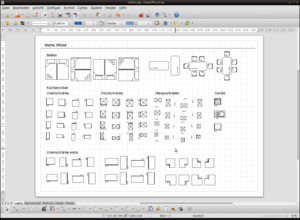
With the help of such libraries you can insert a whole facility into a plan.
This is also suitable for planning a facility as a builder.
Because the scale ensures that you do not "overestimate" the space.
Here, for example, a kitchen with cabinets shown above.
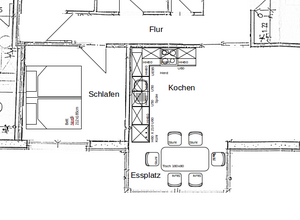
Insert installation icons
You can insert installation symbols in the same way by copy&paste.
From a (self-created) library you take the appropriate characters for sockets, switches, lights, antenna socket (TV and radio), network or telephone.
As far as it makes sense, always put them in their own layers.
The following is the same section of the drawing, this time with installation symbols.
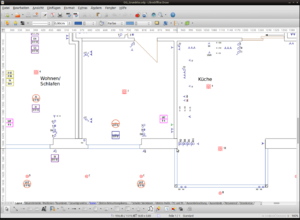
The symbols shown here are accompanied by a library of electric symbols, which are also already arranged in all 4 directions.
Library Electrical
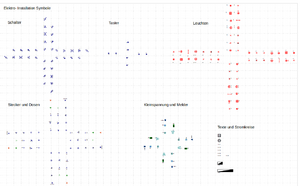
You can buy such libraries or create them yourself.
However, many circuit symbols are not subject to copyright (but libraries are!) and can be downloaded from the Internet as public domain vector graphics.
With these symbols, which are often available in SVG format, you can then quite quickly create a template - document as above.
Look nevertheless times in the Internet under:
https://de.wikipedia.org/wiki/Liste_der_Schaltzeichen_(Elektrik/Elektronik)
or
http://commons.wikimedia.org/wiki/Category:Switch_symbols?uselang=de
Further Informations
Agreements
As a rule, the awarding and contracting regulations for construction services (VOB) are agreed between the client (developer) and the contractor (electrical trade company).
According to VOB C, DIN 18382:2002-12 para. 3.1.6, the contractor (electrical trade company) must prepare all operating and maintenance instructions and necessary as-built drawings required for the safe and economical operation of the system and hand these and individual project-specific data over to the client (initially the developer) (see also VOB C, DIN 18382 para. 3.1.3).
Thus, among other things, the developer must also have a revised installation plan of their plant.
According to VOB C, DIN 18382 Para. 3.1.7, before the completed installation is put into operation, the contractor (electrical trade company) must carry out a test for operational capability and a test in accordance with DIN standards (usually DIN VDE 0100-610 for new installations).
The record of the test results and the documentation must be handed over to the client (initially the developer) before acceptance.
DIN VDE 0100-610 regulates the metrological testing and documentation of each new installation and, if applicable, also of the substantial modification of an existing installation.
According to DIN VDE 0100-610:2004-04 para. 61.1.1, every installation must be tested before it is put into operation by the user.
This must be done during construction and/or after completion, if this makes sense.
Furthermore, according to Paragraph 61.1.6 of this standard, a test report must be drawn up after completion of the test.
Paragraph 612 ff. of the same standard regulates which tests must be carried out.
Thus, the contractor (electrical contractor) must also submit a measurement and handover report to the client (developer).
At a certain point in time, the developer hands over ownership or sells the new building to the customer and thus also the newly installed electrical system, whereby the customer becomes the operator of the electrical system according to DIN VDE 0105-100.
Within the scope of the handover, the operator of the newly constructed electrical system must be handed over, without being requested to do so, all technical documentation, measurement and handover protocols, which in principle only guarantee safe operation of the newly constructed electrical system.
If the developer does not comply with this obligation, he acts unlawfully, even if no VOB Part C was agreed in the purchase contract between the developer and the customer.
This is because both DIN 18382, which is named in VOB Part C, and the corresponding DIN VDE standards are among the generally recognized rules of technology and have general validity with regard to the proof of the principle of safe operation of the newly constructed electrical system.
Thus, as generally accepted rules of technology, they are also valid, for example, within the framework of a standard purchase contract under the German Civil Code (BGB).
The only exception to the legal causality described above is the sale of an existing electrical system.
In this context, as a precautionary measure, every developer is expressly warned against declaring a new installation as an existing old installation before the sale, because the term "existing old installation" has already been clearly defined in several landmark decisions.
Installation plans are necessary and useful
Already with the technical installation of small plants and plant parts it is meaningful to provide installation plans.
These serve the clear representation of the order and help thus to minimize ambiguities from the outset.
In addition, as you could read before, there is a need for revised plans.
This means that the plans, which were the basis for awarding the contract, are adapted to the actual status at the end of the work and now represent the current status of the installation.
In this way, any differences that may arise between the plans immediately become apparent as a significant deviation.
Additional work or shortfalls can then be quickly identified, in addition to correspondence between the contractor and the client.
Work files
all in German [DE]:
"Installationsplan DV.otg" ( Installation Plan Template, A4 Landscape, Various Layers, Blank )
"Installationsplan Muster.odg" ( Document with sample plan )
"Installations-Schaltzeichen DE.odg"
Linux Desktop
Also and especially in connection with the platform Linux you can use wonderfully several desktops.
To do this, open your main document (the installation plan) on desktop 1 and then you can put the document containing the (electrical, or technical) symbols on desktop 2 and if you also want to add furniture or other details, then open a document with corresponding templates on desktop 3.
Switching between these desktops is usually done with a key combination, in Lubuntu for example Ctrl + Alt + → or with the mouse in the panel at the edge of the screen.
Related topics
Documentation / Manuals
Here you will find the Documentation / Manuals:
Any questions?
For questions on this topic go to:
Get Involved
Join us today and help us to make it even better!
Donate
LibreOffice is Free Software and is made available free of charge.
Your donation, which is purely optional, supports our worldwide community.
If you like the software, please consider a Donation.








